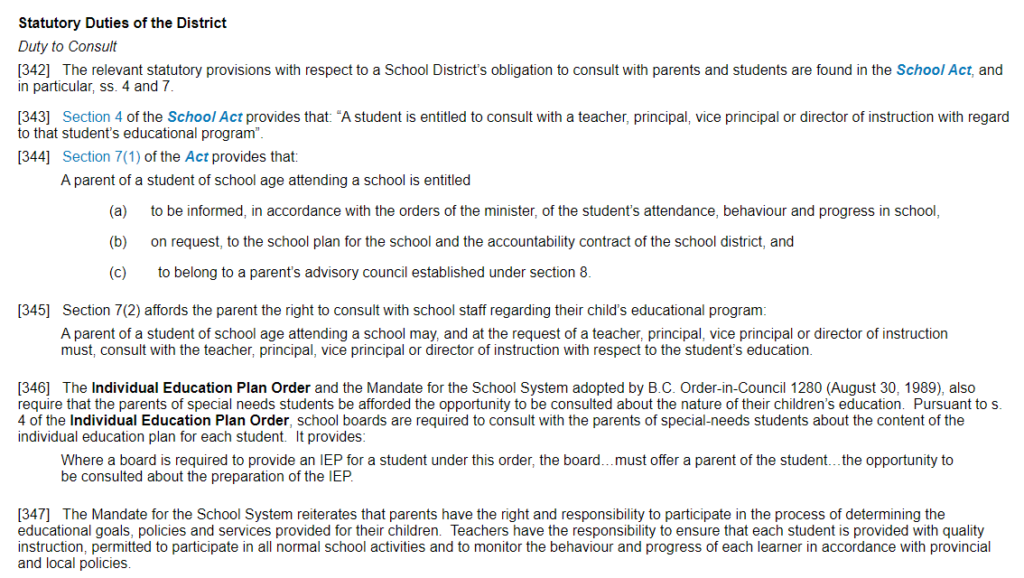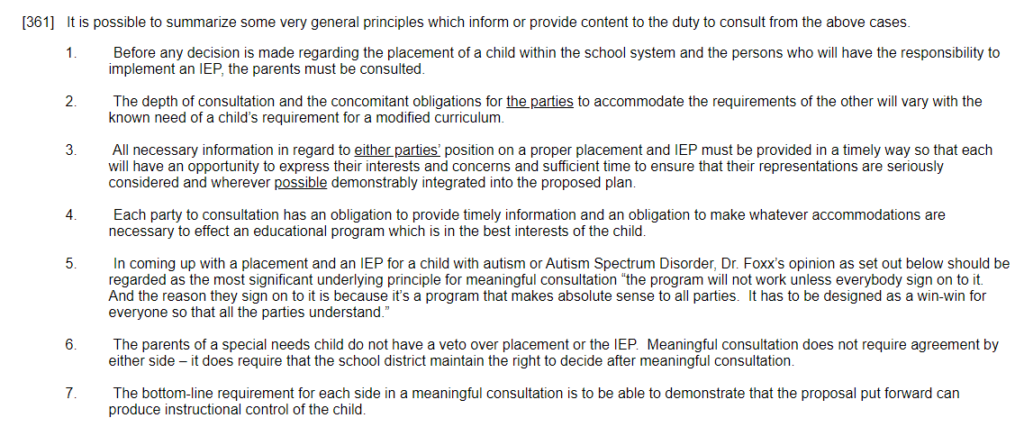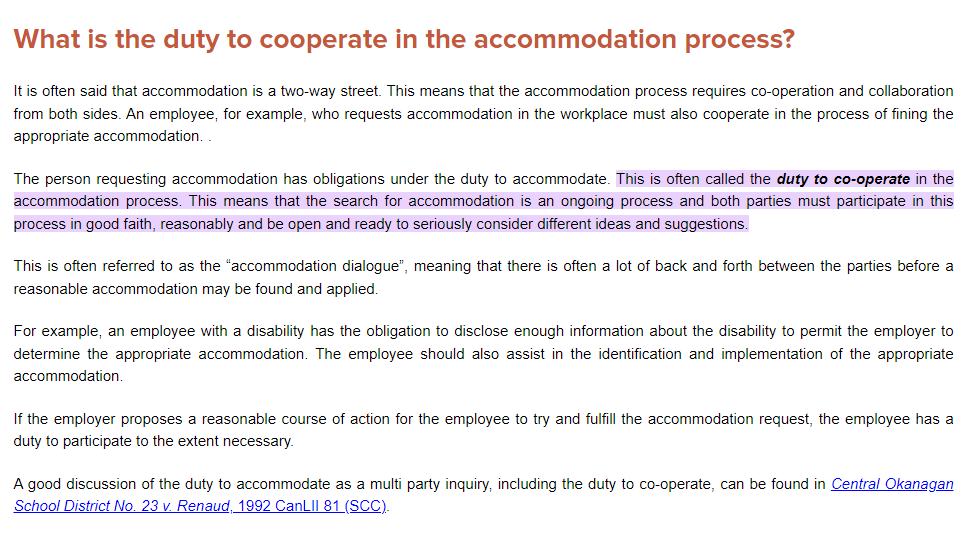Because you need to take your allegations out of the realm of conjecture. Here is a case example below from the BC Human Rights Tribunal.
N obo S v. T and a School District, 2006 BCHRT 546 (CanLII)
[55] In this case, N states that she is a single parent and has several serious medical conditions, and that, because of this, she has been unfairly treated by the respondents. As examples of the unfair treatment, she states that the respondents have failed to return phone calls, delayed letters, failed to provide information in a timely manner, and did not properly investigate her concerns relating to her son. However, she does not include details of any statements or actions on the part of the respondents which would support such a conclusion. She states only that she “believes” that such a connection exists: that she “believes” that the respondents think they can make her go away by exhausting her; that she “believes” that if she had a partner, her child would have equal treatment; and that she “believes” that she would be treated with more respect if she were married, healthy and had financial resources. In other words, nothing in the complaint takes the allegations out of the realm of conjecture, as the facts alleged in the complaint do not support a nexus between N’s marital status and disability and her alleged unfair treatment by the respondents.
[56] As a result of the above, I dismiss N’s complaint pursuant to s. 27(1)(b) of the Code.
*****************************
Allegations are what you are claiming to be true. Until they are proven in a hearing and a decision is complete by a tribunal member, until then, they are nothing more than allegations. Be careful about defamation on social media.
So, parents/guardians and loved ones of disabled children in the education system, what does this mean?
It means we need to be documenting EVERYTHING.
Keeping ALL emails, even the good ones.
Logging calls and dates, with who and what was discussed.
Follow up by email on phone calls to outline what was discussed and action steps agreed upon.
Keeping a timeline of events
Taking photos (if your child has been injured)
When you child tells you what happened at school, take your own notes and write it down. Email your notes to someone you trust to log the date, time and details.
Email other parents and ask them what they know, and make sure they respond in the email and not the phone. The Human Rights Tribunal can take years. People’s memories will change over time, so it’s really important to get the documented information at that time.
If necessary for your own mental health, taking yourself and your child for counselling, (Remember from the blog 10 Most shocking Education Advocacy Discoveries #3) If the counsellor is connected to the government services, they wont be able to testify at a hearing. You need an outside counsellor.)
An added suggestion by Dyslexia BC @DyslexiaBC on Facebook is to bring someone with you to all of your IEP meetings. (That person can take notes, and also be a witness.)
You need to be thinking about collecting evidence. Things that can be used as evidence in a hearing are documents, emails, doctors letters, counselling letters, counselling invoices, videos, photos, media posts, expert evidence, other parents witness statements/emails, voice recordings from meetings, anything that is relevant. Connected. Here is what the Human Rights Tribunal determines to be evidence.
In the same thread of thought, be careful what you offer up in your emails and conversations to the school district. They are also collecting evidence on you.
I will leave you with this case example below.
A and B obo Infant A v. School District C (No. 5), 2018 BCHRT 25 (CanLII)
A. The Mother
[40] Overall, I have found the Mother to be sincere in her testimony. She cares about her Child and became emotional when describing his feelings. However, I do not find her evidence reliable. I find her testimony not to be in “harmony with the preponderance of the probabilities which a practical and informed person would readily recognize as reasonable in that place and in those conditions”. The weight, and thus reliability, of the Mother’s evidence was affected by the fact that her testimony was almost entirely based on hearsay and double hearsay. The Mother was not a witness to most of the interactions she described.
[41] The Tribunal may admit any evidence that it considers necessary and appropriate, whether or not the evidence is admissible in a court of law: Code, s. 27.2. Silver Campsites Ltd. v. James, 2013 BCCA 292 at para. 39. I considered the Mother’s hearsay testimony to be necessary and appropriate because it directly addressed the critical issues in the complaint and there were no other witnesses available to present it. The Father and Child did not testify on these issues. I assessed the Mother’s hearsay evidence on a point-by-point basis, with the objective of ensuring that I could make necessary findings of fact based on reliable evidence: Radek v. Henderson Development (Canada) and Securiguard Services (No. 3), 2005 BCHRT 302 [Radek]. I have considered the following in determining the weight to give to hearsay evidence:
I have considered in each instance the reliability of the evidence, the necessity for its introduction as hearsay rather than first-hand evidence, the probative value of the evidence, and whether the other parties would be unfairly prejudiced or otherwise disadvantaged through my reliance on it. (para. 54)
[42] I have assigned relatively little weight to the Mother’s evidence where it conflicted with the first-hand accounts given by the School Counsellor, Principal, Vice Principal, and Teachers H, M, and G. I have found the Mother’s hearsay evidence considerably less reliable than the direct evidence of reliable witnesses, where there is a conflict.
[43] The Mother acknowledged that she was probably not present for most of the incidents at school that involved her Child. At times, she had a hard time recalling events. For example, the Mother’s testimony on the psychoeducational assessment of her son was wrong by one year. She acknowledged that she was “out a year”. The Mother testified that there is no reason to dispute the emails that were authored by her at the time. The Mother testified “that is what I wrote at that time”.
[44] During cross-examination, the Mother responded to several questions regarding her testimony about her Child’s version of events by saying that she did not know or was not there. She acknowledged that most of her knowledge of the incidents came through her Child. I find that her son was more likely than not motivated to minimize his involvement in some incidents when reporting them to his Parents, so as to avoid discipline. For example, the Mother described disciplining the Child in relation to an incident where he swore at the Principal. She described their punishment as “Draconian”. (In retrospect, the Mother regretted using that word in her letter). As another example, regarding the November 2016 Incident, the Child only reported to his Parents that he grabbed another student by the collar, whereas I find, as a fact, that the Child choked a student, pushed him over a railing, and spat in his face.
[45] The Mother’s credibility was also impacted by her acrimonious relationship with most of the Respondent witnesses. I have considered her contemporaneous correspondence in assessing credibility because it speaks to hear capacity to perceive, recollect, and communicate facts objectively. Together with her husband, the Mother repeatedly sent letters and other communications attacking the character of most of the Respondent witnesses. For example, the Parents wrote letters about the Superintendent to the federal government, provincial government, board of education, RCMP, politicians and others. When confronted with this correspondence, the Mother minimized the tenor of her communications and its effect on the Respondent witnesses. The Mother maintained that she and her husband treated staff respectfully.
[46] The Mother also provided inconsistent testimony. For example, the Mother testified that she did not accuse Teacher G of racism. When confronted during cross-examination, the Mother acknowledged accusing Teacher G of favouring one child over the other, and the other child not necessarily being black. The Mother ultimately acknowledged accusing Teacher G of racism. She explained finding it “very frustrating” when Teacher G prejudged her son and did not follow guidelines.





